Huawei Technologies AP6150DN Wireless LAN Access Point User Manual Product Description
Huawei Technologies Co.,Ltd Wireless LAN Access Point Product Description
User guide

AP6050DN&AP6150DN
Product Description
Issue
05
Date
2017-04-20
HUAWEI TECHNOLOGIES CO., LTD.

Issue 05 (2017-04-20)
Huawei Proprietary and Confidential
Copyright © Huawei Technologies Co., Ltd.
i
Copyright © Huawei Technologies Co., Ltd. 2017. All rights reserved.
No part of this document may be reproduced or transmitted in any form or by any means without prior
written consent of Huawei Technologies Co., Ltd.
Trademarks and Permissions
and other Huawei trademarks are trademarks of Huawei Technologies Co., Ltd.
All other trademarks and trade names mentioned in this document are the property of their respective
holders.
Notice
The purchased products, services and features are stipulated by the contract made between Huawei and
the customer. All or part of the products, services and features described in this document may not be
within the purchase scope or the usage scope. Unless otherwise specified in the contract, all statements,
information, and recommendations in this document are provided "AS IS" without warranties, guarantees or
representations of any kind, either express or implied.
The information in this document is subject to change without notice. Every effort has been made in the
preparation of this document to ensure accuracy of the contents, but all statements, information, and
recommendations in this document do not constitute a warranty of any kind, express or implied.
Huawei Technologies Co., Ltd.
Address:
Huawei Industrial Base
Bantian, Longgang
Shenzhen 518129
People's Republic of China
Website:
http://e.huawei.com
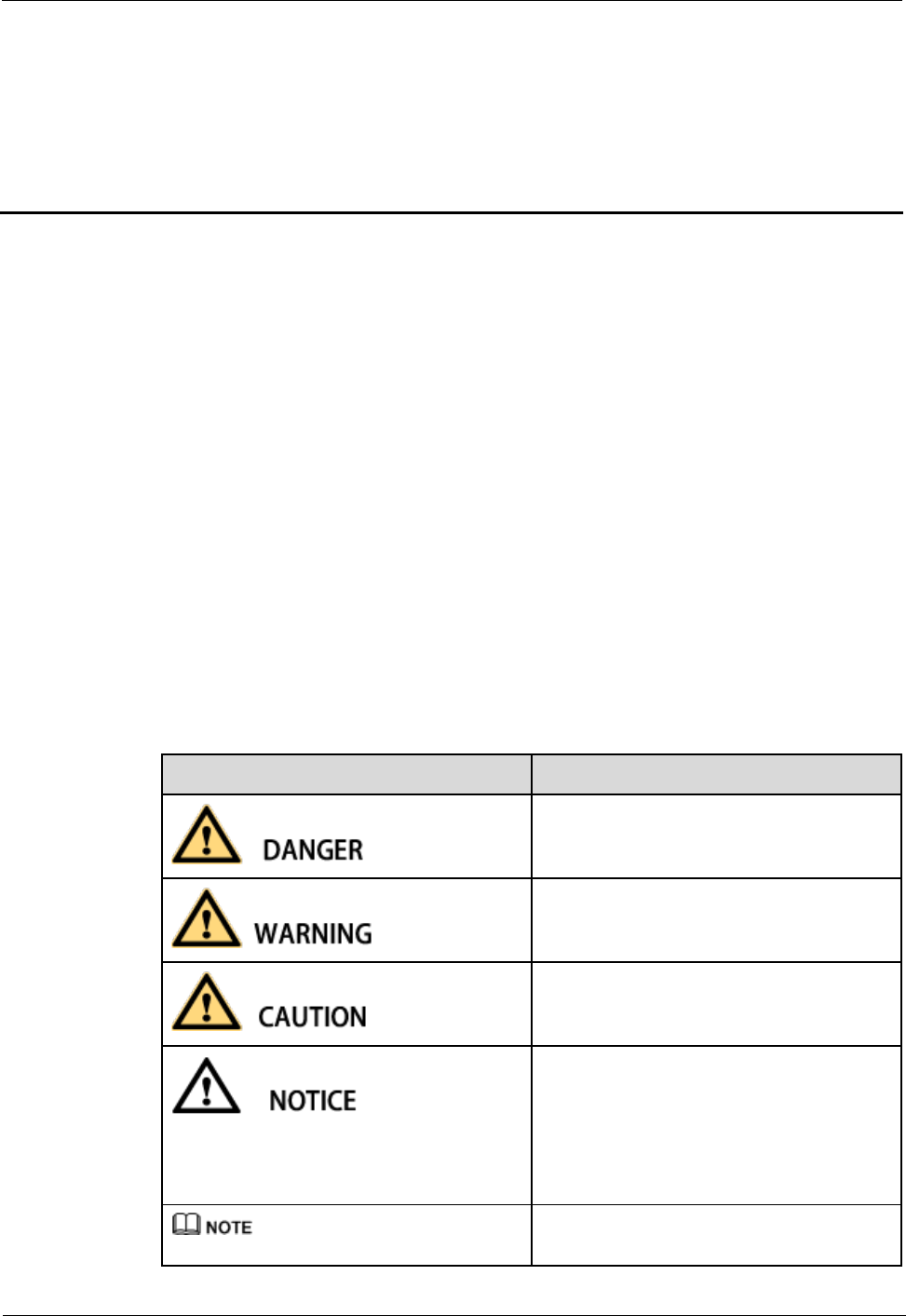
AP6050DN&AP6150DN
Product Description
About This Document
Issue 05 (2017-04-20)
Huawei Proprietary and Confidential
Copyright © Huawei Technologies Co., Ltd.
ii
About This Document
Purpose
This document describes the positioning, characteristics, hardware structure, product features,
and technical specifications of the AP.
This document helps you understand the characteristics and features of the AP.
Intended Audience
This document is intended for network engineers responsible for network design and
deployment. You should understand your network well, including the network topology and
service requirements.
Symbol Conventions
The symbols that may be found in this document are defined as follows.
Symbol
Description
Indicates an imminently hazardous situation
which, if not avoided, will result in death or
serious injury.
Indicates a potentially hazardous situation
which, if not avoided, could result in death
or serious injury.
Indicates a potentially hazardous situation
which, if not avoided, may result in minor
or moderate injury.
Indicates a potentially hazardous situation
which, if not avoided, could result in
equipment damage, data loss, performance
deterioration, or unanticipated results.
NOTICE is used to address practices not
related to personal injury.
Calls attention to important information,
best practices and tips.

AP6050DN&AP6150DN
Product Description
About This Document
Issue 05 (2017-04-20)
Huawei Proprietary and Confidential
Copyright © Huawei Technologies Co., Ltd.
iii
Symbol
Description
NOTE is used to address information not
related to personal injury, equipment
damage, and environment deterioration.
Change History
Changes between document issues are cumulative. The latest document issue contains all the
changes made in previous issues.
Changes in Issue 05 (2017-04-20)
This version has the following updates:
The following information is modified:
3.3 QoS Features
Changes in Issue 04 (2016-11-22)
This version has the following updates:
The following information is modified:
5.1 Basic Specifications
5.2 Radio Specifications
Changes in Issue 03 (2016-10-15)
This version has the following updates:
The following information is added:
4 Product Features (in Cloud-based Management Mode)
The following information is modified:
2.1 AP6050DN
2.2 AP6150DN
Changes in Issue 02 (2016-07-22)
This version has the following updates:
The following information is modified:
5.1 Basic Specifications
5.2 Radio Specifications
Changes in Issue 01 (2016-05-31)
This is the initial commercial release.

AP6050DN&AP6150DN
Product Description
Contents
Issue 05 (2017-04-20)
Huawei Proprietary and Confidential
Copyright © Huawei Technologies Co., Ltd.
iv
Contents
About This Document .................................................................................................................... ii
1 Product Positioning and Characteristics ................................................................................... 1
1.1 Product Positioning ....................................................................................................................................................... 1
1.2 Product Characteristics ................................................................................................................................................. 7
2 Hardware Structure..................................................................................................................... 10
2.1 AP6050DN .................................................................................................................................................................. 10
2.2 AP6150DN .................................................................................................................................................................. 13
3 Product Features (in Fat AP and Fit AP Modes) .................................................................... 17
3.1 WLAN Features .......................................................................................................................................................... 17
3.2 Network Features ........................................................................................................................................................ 18
3.3 QoS Features ............................................................................................................................................................... 18
3.4 Security Features ........................................................................................................................................................ 19
3.5 Maintenance Features ................................................................................................................................................. 19
3.6 BYOD ......................................................................................................................................................................... 20
3.7 Locating Service ......................................................................................................................................................... 20
3.8 Spectrum Analysis ...................................................................................................................................................... 20
4 Product Features (in Cloud-based Management Mode) ...................................................... 21
5 Technical Specifications ............................................................................................................ 24
5.1 Basic Specifications .................................................................................................................................................... 24
5.2 Radio Specifications ................................................................................................................................................... 25
5.3 Standards Compliance ................................................................................................................................................ 31

AP6050DN&AP6150DN
Product Description
1 Product Positioning and Characteristics
Issue 05 (2017-04-20)
Huawei Proprietary and Confidential
Copyright © Huawei Technologies Co., Ltd.
1
1 Product Positioning and Characteristics
About This Chapter
1.1 Product Positioning
1.2 Product Characteristics
1.1 Product Positioning
Table 1-1 Product positioning
Product
Model
Frequency
Band
IEEE
Standards
Compliance
Positioning
Usage
Scenario
AP6050DN
AP6150DN
Dual band:
2.4 GHz
5 GHz
The AP6050DN
and AP6150DN
can provide
services
simultaneously
on the 2.4 GHz
and 5 GHz
frequency
bands to
support more
access users.
IEEE
802.11a/b/g/n/a
c/ac wave2
The AP6050DN
and AP6150DN
are the
next-generation
technology-lead
ing APs. They
support 4×4
MU-MIMO and
feature high
reliability, high
security, simple
network
deployment,
automatic AC
discovery and
configuration,
and real-time
management
and
maintenance. In
compliance
with IEEE
802.11ac, the
The AP6050DN
and AP6150DN
provide
highest-quality
wireless
services for
mobile office,
high-density
scenarios,
elementary
education, and
higher
education. They
provide flexible
distribution
options in
different
environments.

AP6050DN&AP6150DN
Product Description
1 Product Positioning and Characteristics
Issue 05 (2017-04-20)
Huawei Proprietary and Confidential
Copyright © Huawei Technologies Co., Ltd.
2
Product
Model
Frequency
Band
IEEE
Standards
Compliance
Positioning
Usage
Scenario
AP6050DN and
AP6150DN
support a
theoretical rate
of up to 2.53
Gbit/s, greatly
improving user
experience.
The AP6050DN and AP6150DN can work as a Fat AP, Fit AP, or cloud AP. The AP can
switch flexibly among three working modes based on the network plan.
Typical networking modes are as follows:
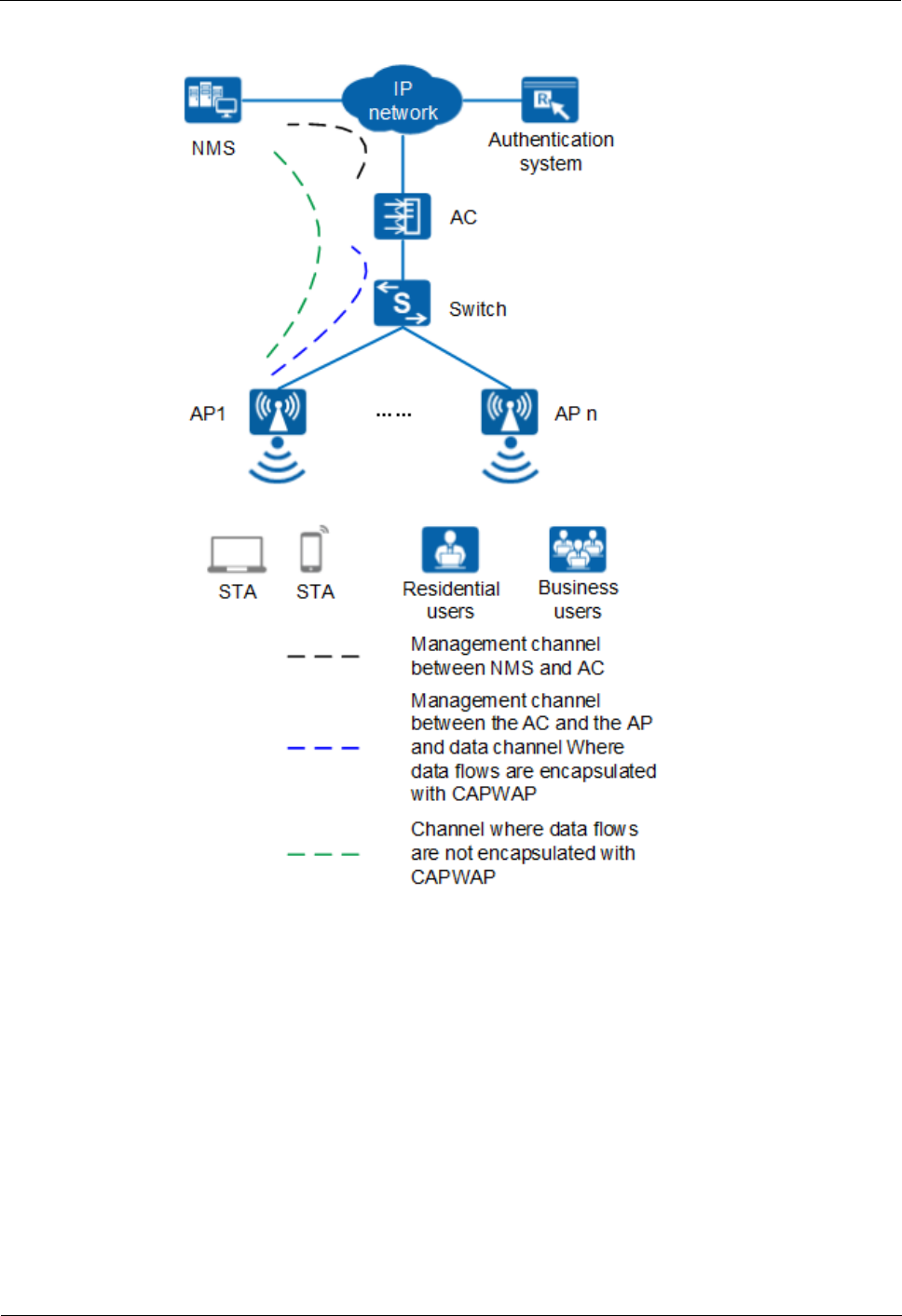
AP6050DN&AP6150DN
Product Description
1 Product Positioning and Characteristics
Issue 05 (2017-04-20)
Huawei Proprietary and Confidential
Copyright © Huawei Technologies Co., Ltd.
3
Figure 1-1 Fit AP networking (AP mode)
In this networking, the AP functions as a Fit AP. The AC is responsible for user access, AP
go-online, AP management, authentication, routing, security, and QoS. Huawei products that
provide the AC function include the AC6605, AC6005, ACU2 (with S7700, S9700, or
S12700), S5720HI, S6720HI, S7700 (with X series board), S9700 (with X series board), and
S12700 (with X series board).
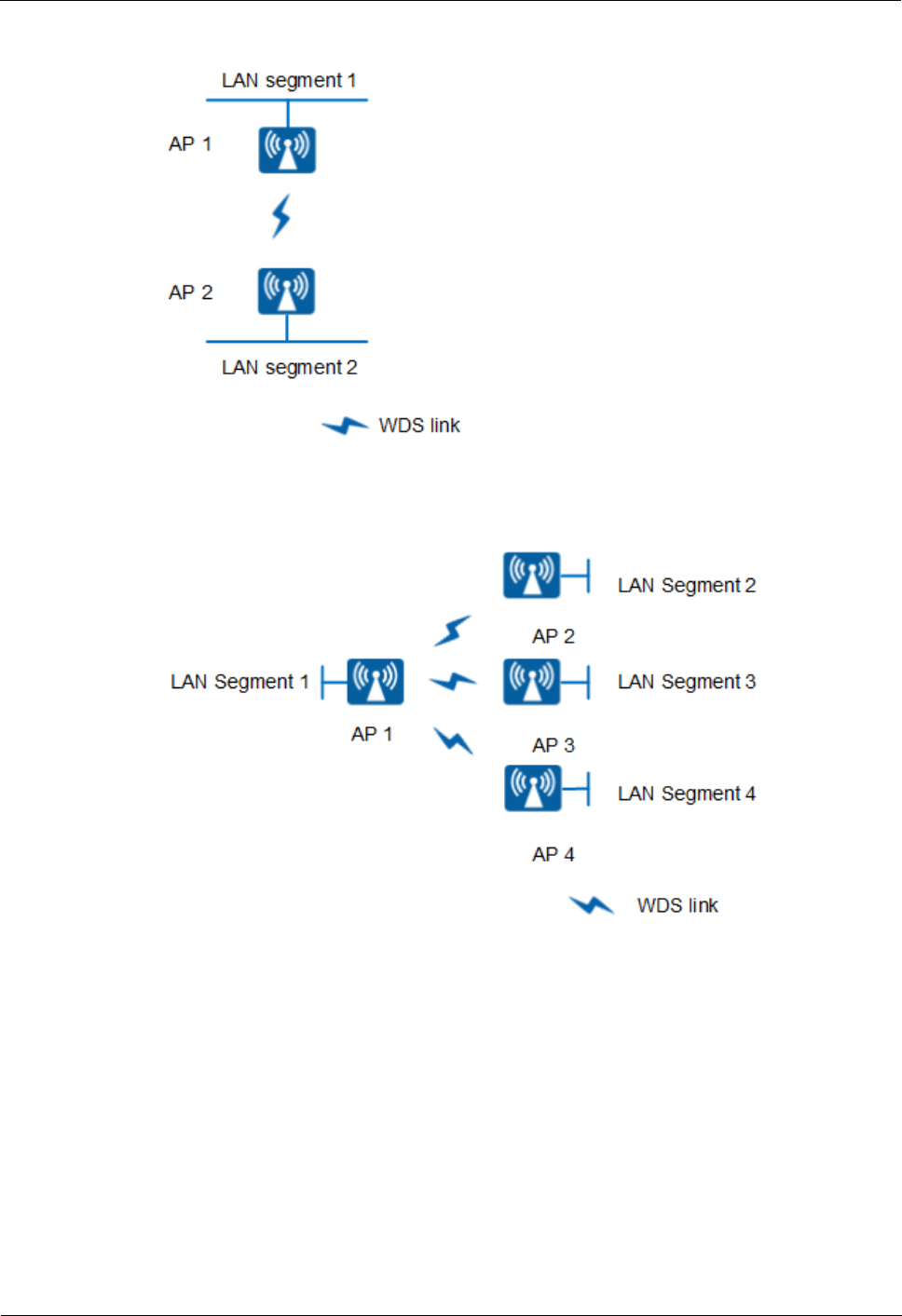
AP6050DN&AP6150DN
Product Description
1 Product Positioning and Characteristics
Issue 05 (2017-04-20)
Huawei Proprietary and Confidential
Copyright © Huawei Technologies Co., Ltd.
4
Figure 1-2 Fit AP networking (WDS mode: point-to-point)
Figure 1-3 Fit AP networking (WDS mode: point-to-multipoint)
In this networking, the AP connects two or more independently wired or wireless LANs
through wireless links to construct a network on which users can exchange data. In Wireless
Distribution System (WDS) mode, the AP supports point-to-point (P2P) and
point-to-multipoint (P2MP) networking modes. Supporting 5 GHz and 2.4 GHz frequency
bands, the AP can implement wireless bridging and access functions.
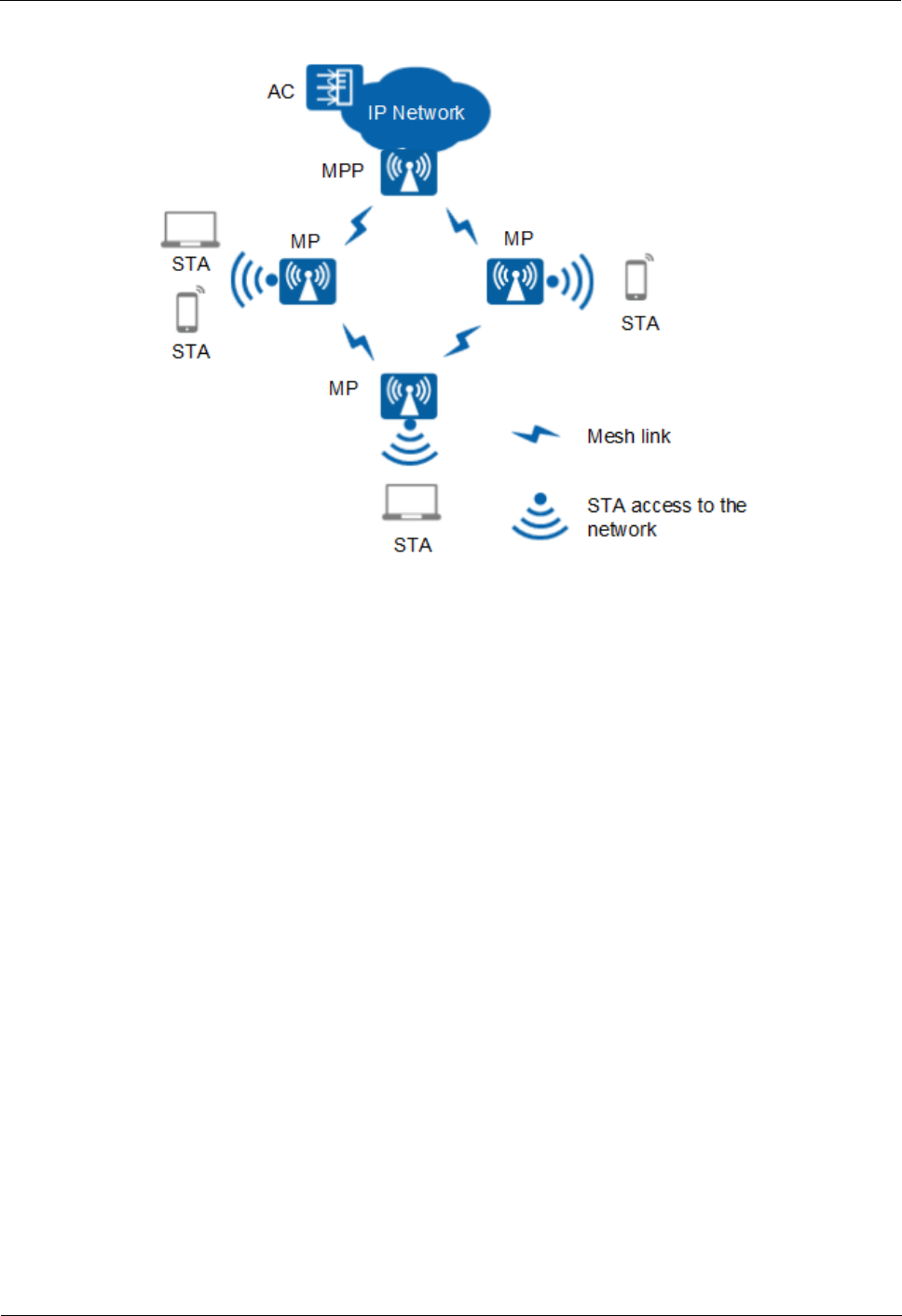
AP6050DN&AP6150DN
Product Description
1 Product Positioning and Characteristics
Issue 05 (2017-04-20)
Huawei Proprietary and Confidential
Copyright © Huawei Technologies Co., Ltd.
5
Figure 1-4 Fit AP mesh networking
In this networking, APs function as mesh points (MPs) and are fully meshed to establish an
auto-configured and self-healing wireless mesh network (WMN). APs with the gateway
function can work as the mesh portal points (MPPs) through which the WMN can provide
access to the Internet. Terminals connect to APs to access the WMN. The WMN uses
dedicated mesh routing protocols to guarantee high transmission quality and is more
applicable to scenarios that require high bandwidth and highly stable Internet connections.
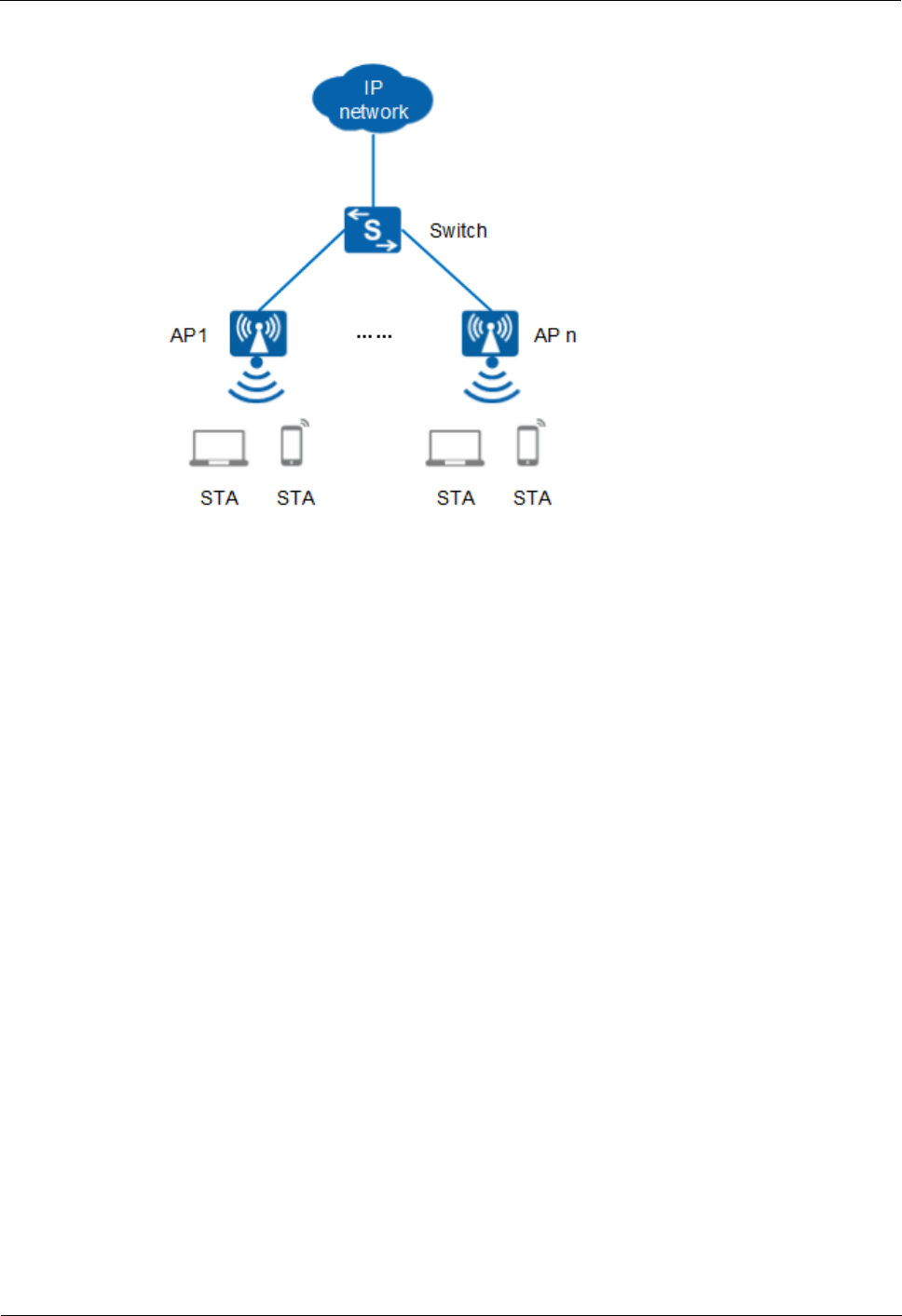
AP6050DN&AP6150DN
Product Description
1 Product Positioning and Characteristics
Issue 05 (2017-04-20)
Huawei Proprietary and Confidential
Copyright © Huawei Technologies Co., Ltd.
6
Figure 1-5 Fat AP networking
In this networking, the device functions as a Fat AP to implement functions such as user
access, authentication, data security, service forwarding, and QoS.
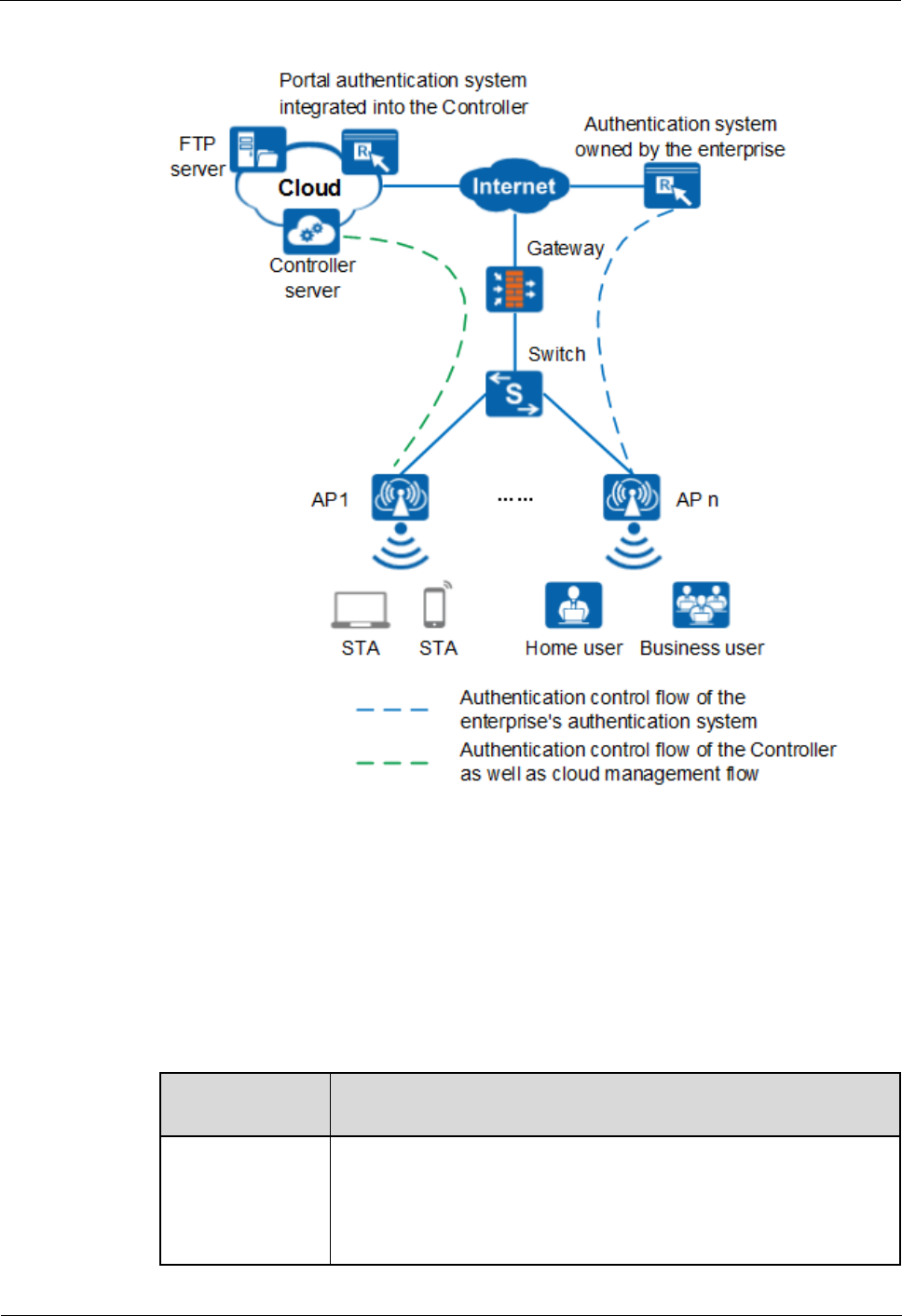
AP6050DN&AP6150DN
Product Description
1 Product Positioning and Characteristics
Issue 05 (2017-04-20)
Huawei Proprietary and Confidential
Copyright © Huawei Technologies Co., Ltd.
7
Figure 1-6 Cloud AP networking
In this networking, the device functions as a cloud AP and works with the Agile
Controller-Campus on the same cloud for user access, AP online, authentication, routing, AP
management, security, and QoS. An enterprise can choose to use the Portal authentication
server integrated in the Agile Controller-Campus or the authentication server deployed by
itself.
1.2 Product Characteristics
Product
Characteristics
Description
High-speed and
reliable wireless
access
Compatibility with IEEE 802.11a/b/g/n/ac/ac wave 2.
Supports 4×4 MU-MIMO and a rate up to 2.53 Gbit/s.
Supports a rate of up to 800 Mbit/s at 2.4 GHz frequency band.
Supports a rate of up to 1.73 Gbit/s at 5 GHz frequency band.

AP6050DN&AP6150DN
Product Description
1 Product Positioning and Characteristics
Issue 05 (2017-04-20)
Huawei Proprietary and Confidential
Copyright © Huawei Technologies Co., Ltd.
8
Product
Characteristics
Description
Supports link aggregation of dual Ethernet ports.
Supports Wi-Fi Multimedia (WMM) and priority mapping on the
air interface and wired interface.
Supports wired link integrity check.
Supports load balancing.
Supports roaming without service interruption in Fit AP mode.
Supports AC dual-link backup in Fit AP mode.
Supports beamforming.
Provides a latest 802.11ac Wave 2 chip with higher performance
and wider coverage.
Uses a metal shell and heat dissipation design to ensure high
reliability.
Comprehensive
user access control
capability
Supports access control lists (ACLs) and implements user access
control based on the user group policy.
Provides fine-grained bandwidth management for each user.
Supports user isolation policies.
Supports unified authentication on the AC in Fit AP mode.
Identifies the device type according to the organizationally unique
identifier (OUI) in the MAC address, user agent (UA) information
in an HTTP packet, and DHCP options in Fit AP mode.
The RADIUS server delivers packet forwarding, security, and
QoS policies according to the device type carried in the RADIUS
authentication and accounting packets in Fit AP mode.
High network
security
Open system authentication
WEP authentication/encryption
WPA/WPA2-PSK authentication and encryption
WPA/WPA2-802.1x authentication and encryption
Wireless intrusion detection system (WIDS) and wireless
intrusion prevention system (WIPS), including rogue device
detection and countermeasure, attack detection and dynamic
blacklist, and STA/AP blacklist and whitelist
Flexible
networking and
environment
adaptability
Provides flexible networking capabilities and applies to various
application scenarios.
Has strong environment adaptability. The AP can automatically
select the transmission rates, channels, and transmit power to
adapt to various radio environments and avoid interference in real
time.
Adjusts bandwidth allocation based on the user quantity and
environment to improve user experience.
The AP6050DN supports the MIMO antenna system equipped
with built-in dual-band omnidirectional antennas.
The AP6150DN supports the MIMO antenna system equipped
with external dual-band omnidirectional antennas.

AP6050DN&AP6150DN
Product Description
1 Product Positioning and Characteristics
Issue 05 (2017-04-20)
Huawei Proprietary and Confidential
Copyright © Huawei Technologies Co., Ltd.
9
Product
Characteristics
Description
Works in Fit AP mode to identify interference sources such as
baby monitors, Bluetooth devices, digital cordless phones (at 2.4
GHz frequency band only), wireless audio transmitters (at both the
2.4 GHz and 5 GHz frequency bands), wireless game controllers,
and microwaves, and works together with eSight to display
spectrums of interference sources.
Easy device
management and
maintenance
Works in Fit AP mode to support automatic going-online,
configuration loading, and plug-and-play (PnP).
Supports batch upgrade.
Works in Fat AP mode to support HTTP or HTTPS login to the
web platform to achieve local management and maintenance.
Allows real-time monitoring on the network management system
(NMS) to facilitate remote configuration and fast fault location.
Supports the Link Layer Discovery Protocol (LLDP) to implement
automatic link discovery and obtain the network topology.
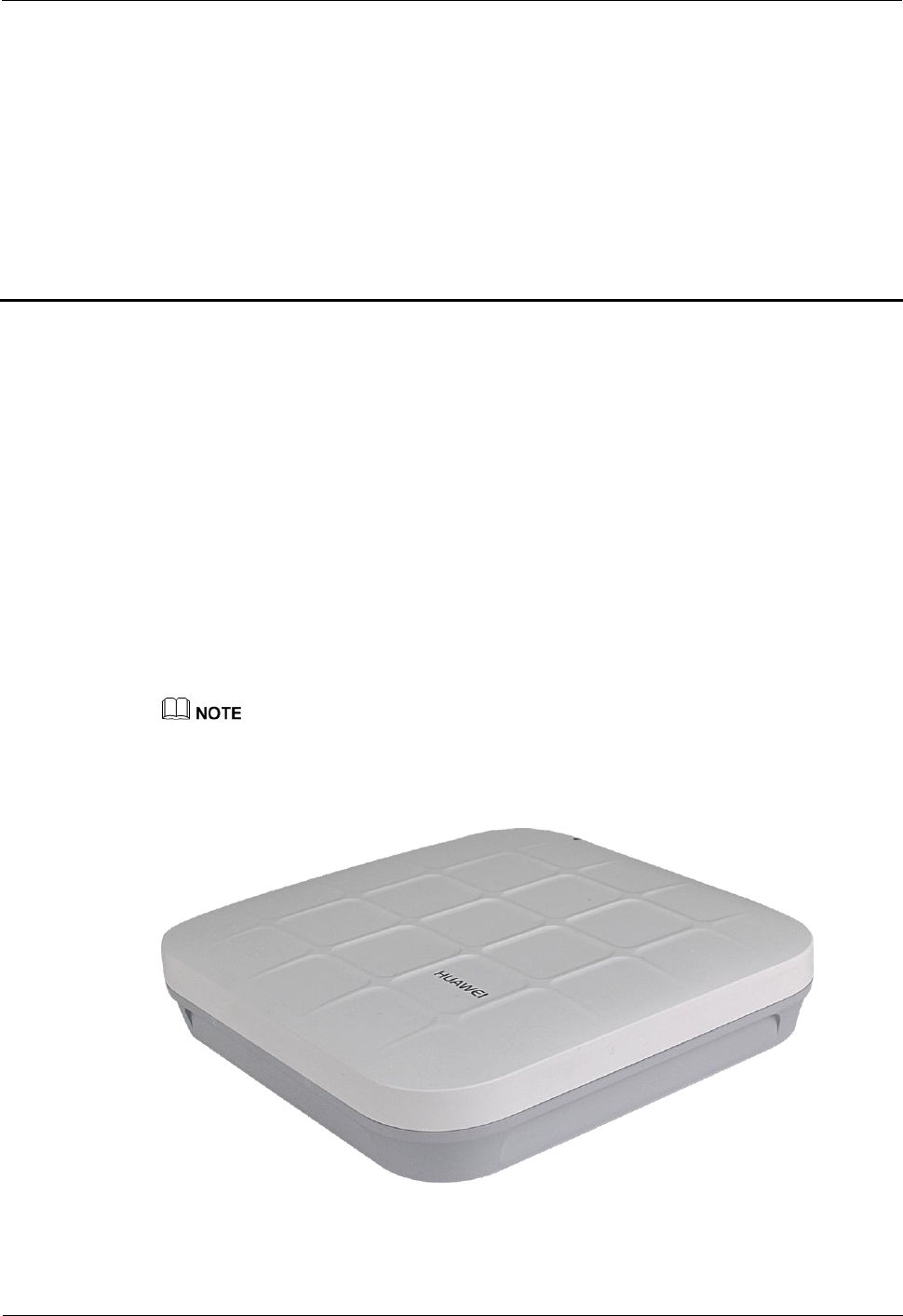
AP6050DN&AP6150DN
Product Description
2 Hardware Structure
Issue 05 (2017-04-20)
Huawei Proprietary and Confidential
Copyright © Huawei Technologies Co., Ltd.
10
2 Hardware Structure
About This Chapter
2.1 AP6050DN
2.2 AP6150DN
2.1 AP6050DN
Appearance
Figure 2-1 shows the appearance of the AP.
The actual device appearance may be different from the following device appearance, but these
differences will not affect device functions.
Figure 2-1 AP6050DN appearance
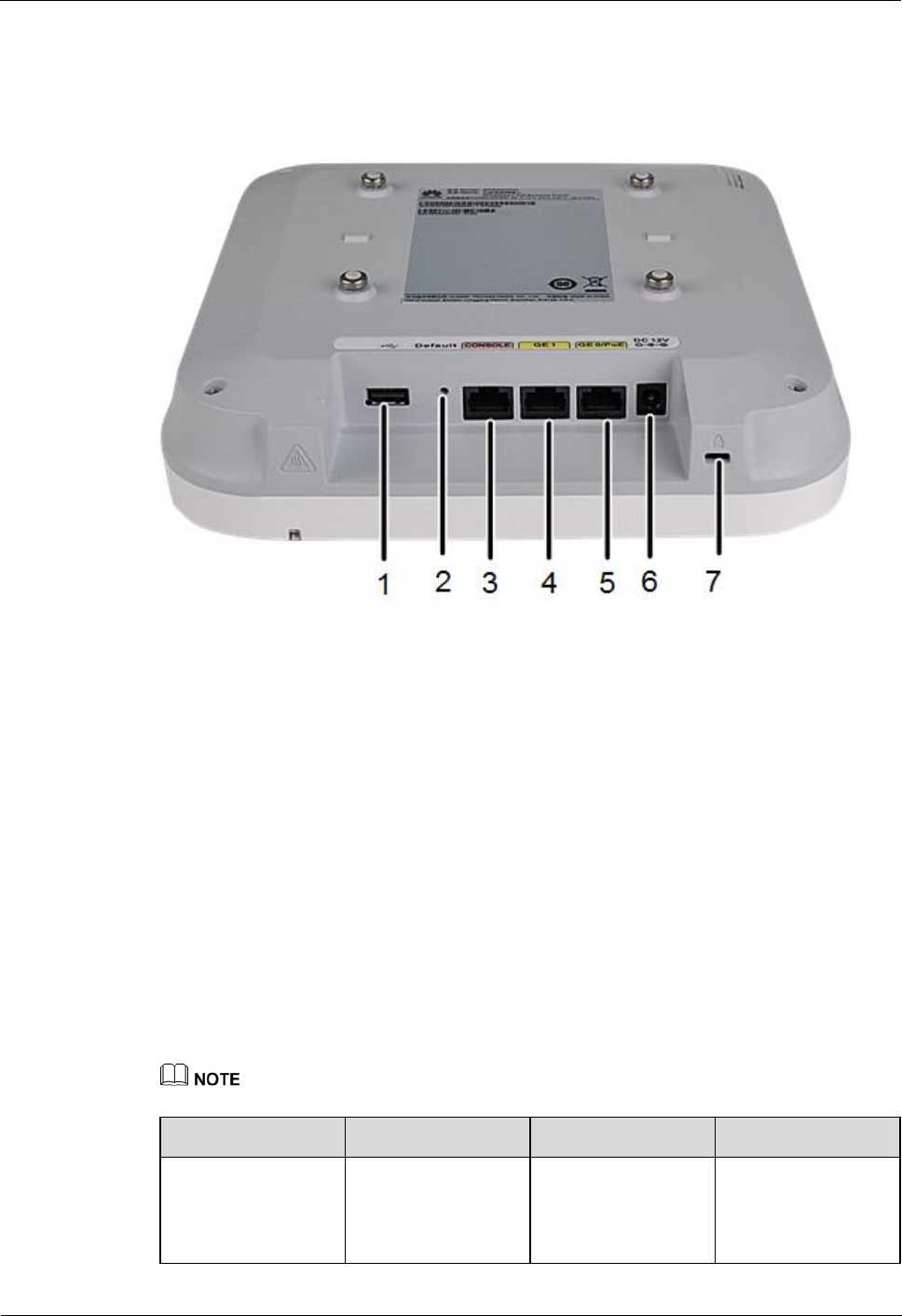
AP6050DN&AP6150DN
Product Description
2 Hardware Structure
Issue 05 (2017-04-20)
Huawei Proprietary and Confidential
Copyright © Huawei Technologies Co., Ltd.
11
Port
The following figure shows ports on the AP6050DN.
Figure 2-2 AP6050DN ports
As shown in Figure 2-2, each port can be described as follows:
1. USB port: connects to a USB flash drive to extend the storage space of the AP, and
provides a maximum of 2.5 W power.
2. Default button: restores factory settings if you hold down the button more than 3
seconds.
3. Console port: connects to the maintenance terminal for AP configuration and
management.
4. GE1: 10/100/1000M port used to connect to the wired Ethernet.
5. GE0/PoE: 10/100/1000M port used to connect to the wired Ethernet. The port can
connect to a PoE power supply to provide power for APs.
6. Input port for 12 V DC power supply.
7. Lock port: protects the AP against theft.
LED Indicators
Indicator colors may vary slightly at different temperature.
Type
Color
Status
Description
Default status after
power-on
Green
Steady on
The AP is just
powered on and the
software is not
started yet.

AP6050DN&AP6150DN
Product Description
2 Hardware Structure
Issue 05 (2017-04-20)
Huawei Proprietary and Confidential
Copyright © Huawei Technologies Co., Ltd.
12
Type
Color
Status
Description
Software startup
status
Green
Steady on after
blinking once
After the system is
reset and starts
uploading the
software, the
indicator blinks
green once. Until the
software is uploaded
and started, the
indicator remains
steady green.
Running status
Green
Blinking once every
2s (0.5 Hz)
The system is
running properly,
the Ethernet
connection is
normal, and
STAs are
associated with
the AP.
The system
enters the Uboot
CLI.
Blinking once every
5s (0.2 Hz)
The system is
running properly,
the Ethernet
connection is
normal, and no STA
is associated with
the AP. The system
is in low power
consumption state.
Alarm
Green
Blinking once every
0.25s (4 Hz)
The software is
being upgraded.
After the
software is
loaded and
started, the AP
requests to go
online if it works
in Fit AP or
cloud-based
management
mode. The
indicator remains
in this state
before the AP
successfully goes
online.
The AP works in
Fit AP or
cloud-based
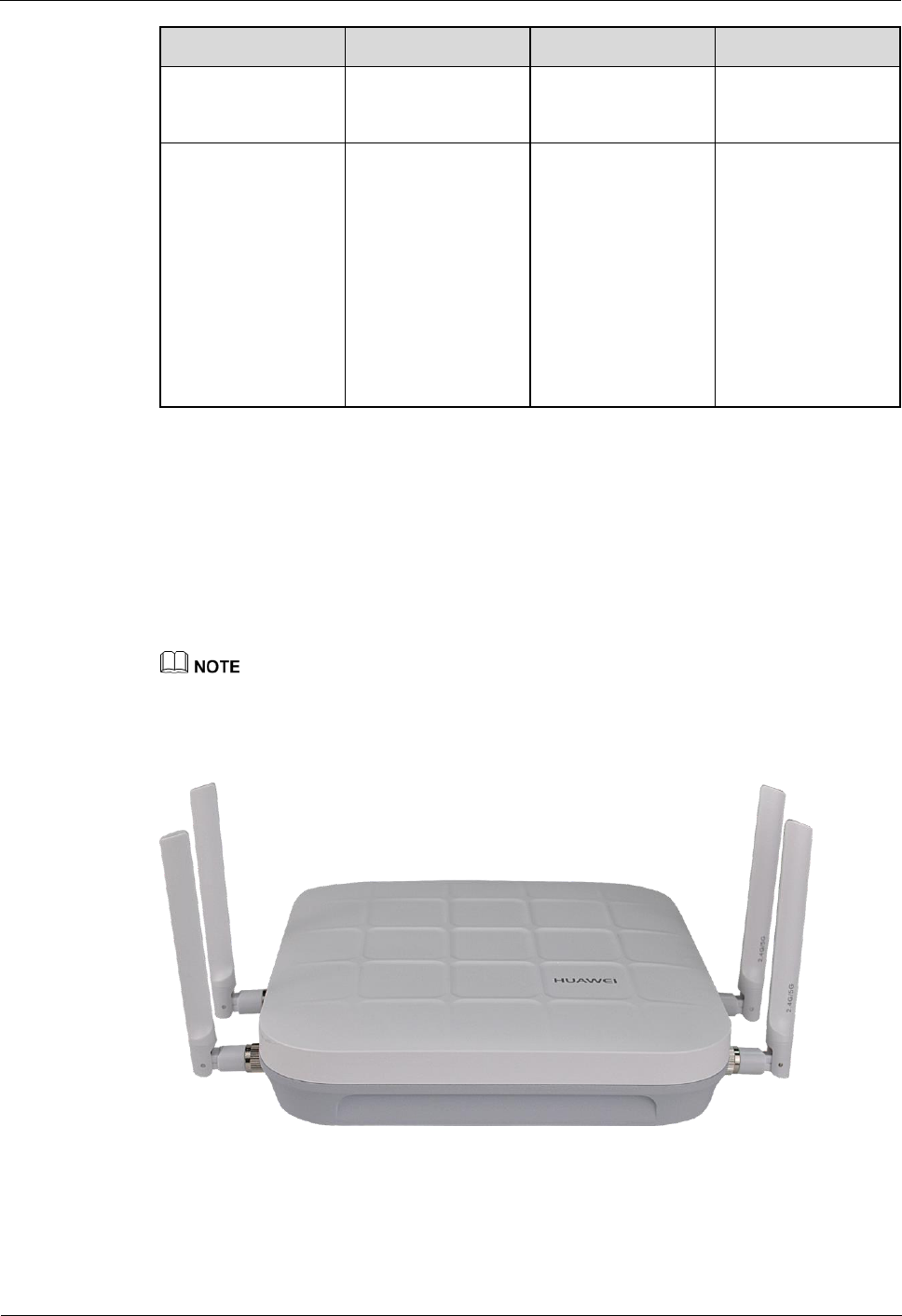
AP6050DN&AP6150DN
Product Description
2 Hardware Structure
Issue 05 (2017-04-20)
Huawei Proprietary and Confidential
Copyright © Huawei Technologies Co., Ltd.
13
Type
Color
Status
Description
management
mode and fails to
go online.
Fault
Red
Steady on
A fault that affects
services has
occurred, such as a
DRAM detection
failure or system
software loading
failure. The fault
cannot be
automatically
rectified and must be
rectified manually.
2.2 AP6150DN
Appearance
Figure 2-3 shows the appearance of the AP.
The actual device appearance may be different from the following device appearance, but these
differences will not affect device functions.
Figure 2-3 AP6150DN appearance
Port
The following figure shows ports on the AP6150DN.
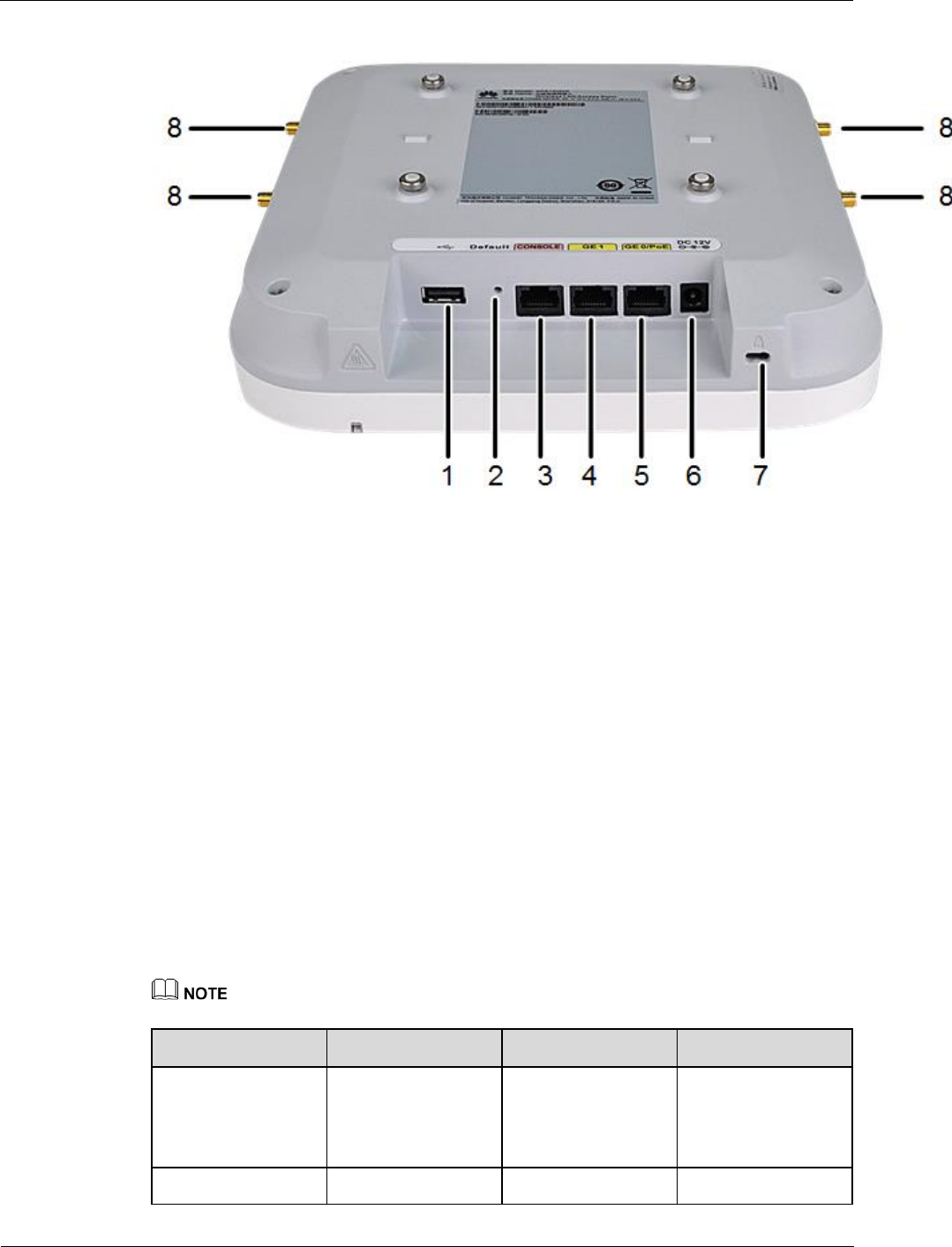
AP6050DN&AP6150DN
Product Description
2 Hardware Structure
Issue 05 (2017-04-20)
Huawei Proprietary and Confidential
Copyright © Huawei Technologies Co., Ltd.
14
Figure 2-4 AP6150DN ports
As shown in Figure 2-4, each port can be described as follows:
1. USB port: connects to a USB flash drive to extend the storage space of the AP, and
provides a maximum of 2.5 W power.
2. Default button: restores factory settings if you hold down the button more than 3
seconds.
3. Console port: connects to the maintenance terminal for AP configuration and
management.
4. GE1: 10/100/1000M port used to connect to the wired Ethernet.
5. GE0/PoE: 10/100/1000M port used to connect to the wired Ethernet. The port can
connect to a PoE power supply to provide power for APs.
6. Input port for 12 V DC power supply.
7. Lock port: protects the AP against theft.
8. Antenna port: Connects an antenna to the AP to send and receive wireless signals. The
port type is RP-SMA-K.
LED Indicators
Indicator colors may vary slightly at different temperature.
Type
Color
Status
Description
Default status after
power-on
Green
Steady on
The AP is just
powered on and the
software is not
started yet.
Software startup
Green
Steady on after
After the system is

AP6050DN&AP6150DN
Product Description
2 Hardware Structure
Issue 05 (2017-04-20)
Huawei Proprietary and Confidential
Copyright © Huawei Technologies Co., Ltd.
15
Type
Color
Status
Description
status
blinking once
reset and starts
uploading the
software, the
indicator blinks
green once. Until the
software is uploaded
and started, the
indicator remains
steady green.
Running status
Green
Blinking once every
2s (0.5 Hz)
The system is
running properly,
the Ethernet
connection is
normal, and
STAs are
associated with
the AP.
The system
enters the Uboot
CLI.
Blinking once every
5s (0.2 Hz)
The system is
running properly,
the Ethernet
connection is
normal, and no STA
is associated with
the AP. The system
is in low power
consumption state.
Alarm
Green
Blinking once every
0.25s (4 Hz)
The software is
being upgraded.
After the
software is
loaded and
started, the AP
requests to go
online if it works
in Fit AP or
cloud-based
management
mode. The
indicator remains
in this state
before the AP
successfully goes
online.
The AP works in
Fit AP or
cloud-based
management

AP6050DN&AP6150DN
Product Description
2 Hardware Structure
Issue 05 (2017-04-20)
Huawei Proprietary and Confidential
Copyright © Huawei Technologies Co., Ltd.
16
Type
Color
Status
Description
mode and fails to
go online.
Fault
Red
Steady on
A fault that affects
services has
occurred, such as a
DRAM detection
failure or system
software loading
failure. The fault
cannot be
automatically
rectified and must be
rectified manually.

AP6050DN&AP6150DN
Product Description
3 Product Features (in Fat AP and Fit AP Modes)
Issue 05 (2017-04-20)
Huawei Proprietary and Confidential
Copyright © Huawei Technologies Co., Ltd.
17
3 Product Features (in Fat AP and Fit AP
Modes)
About This Chapter
3.1 WLAN Features
3.2 Network Features
3.3 QoS Features
3.4 Security Features
3.5 Maintenance Features
3.6 BYOD
3.7 Locating Service
3.8 Spectrum Analysis
3.1 WLAN Features
WLAN features supported by the AP are as follows:
Compliance with IEEE 802.11a/b/g/n/ac/ac Wave 2
Maximum rate of 2.53 Gbit/s
Maximum ratio combining (MRC)
Space time block code (STBC)
Beamforming
MU-MIMO
Low-density parity-check (LDPC)
Maximum-likelihood detection (MLD)
Frame aggregation, including A-MPDU (Tx/Rx) and A-MSDU (Tx/Rx)
802.11 dynamic frequency selection (DFS)
Short guard interval (GI) in 20 MHz, 40 MHz, 80 MHz, 160 MHz, and 80+80 MHz
modes

AP6050DN&AP6150DN
Product Description
3 Product Features (in Fat AP and Fit AP Modes)
Issue 05 (2017-04-20)
Huawei Proprietary and Confidential
Copyright © Huawei Technologies Co., Ltd.
18
Priority mapping and packet scheduling based on a Wi-Fi Multimedia (WMM) profile to
implement priority-based data processing and forwarding
Automatic and manual rate adjustment
WLAN channel management and channel rate adjustment
For details about WLAN channel management, see the Country Code & Channel Compliance Table.
Automatic channel scanning and interference avoidance
Service set identifier (SSID) hiding
Signal sustain technology (SST)
Unscheduled automatic power save delivery (U-APSD)
Control and Provisioning of Wireless Access Points (CAPWAP) in Fit AP mode
Automatic login in Fit AP mode
Extended Service Set (ESS) in Fit AP mode
Wireless distribution system (WDS) in Fit AP mode
Mesh networking in Fit AP mode
Multi-user CAC
3.2 Network Features
Network features supported by the AP are as follows:
Compliance with IEEE 802.3ab
Auto-negotiation of the rate and duplex mode and automatic switchover between the
Media Dependent Interface (MDI) and Media Dependent Interface Crossover (MDI-X)
Compliance with IEEE 802.1q
SSID-based VLAN assignment
VLAN trunk on uplink Ethernet ports
Management channel of the AP uplink port in tagged and untagged mode
DHCP client, obtaining IP addresses through DHCP
Tunnel data forwarding and direct data forwarding
STA isolation in the same VLAN
Access control lists (ACLs)
Link Layer Discovery Protocol (LLDP)
Uninterrupted service forwarding upon CAPWAP channel disconnection in Fit AP mode
Unified authentication on the AC in Fit AP mode
AC dual-link backup in Fit AP mode
Network Address Translation (NAT) in Fat AP mode
IPv6 in Fit AP mode
3.3 QoS Features
QoS features supported by the AP are as follows:

AP6050DN&AP6150DN
Product Description
3 Product Features (in Fat AP and Fit AP Modes)
Issue 05 (2017-04-20)
Huawei Proprietary and Confidential
Copyright © Huawei Technologies Co., Ltd.
19
Priority mapping and packet scheduling based on a Wi-Fi Multimedia (WMM) profile to
implement priority-based data processing and forwarding
WMM parameter management for each radio
WMM power saving
Priority mapping for upstream packets and flow-based mapping for downstream packets
Queue mapping and scheduling
User-based bandwidth limiting
Adaptive bandwidth management (automatic bandwidth adjustment based on the user
quantity and radio environment) to improve user experience
Smart Application Control (SAC) in Fit AP mode
3.4 Security Features
Security features supported by the AP are as follows:
Open system authentication
WEP authentication/encryption using a 64-bit, 128-bit, or 152-bit encryption key
WPA/WPA2-PSK authentication and encryption (WPA/WPA2 personal edition)
WPA/WPA2-802.1x authentication and encryption (WPA/WPA2 enterprise edition)
WPA-WPA2 hybrid authentication
WAPI authentication and encryption
Wireless intrusion detection system (WIDS) and wireless intrusion prevention system
(WIPS), including rogue device detection and countermeasure, attack detection and
dynamic blacklist, and STA/AP blacklist and whitelist
802.1x authentication, MAC address authentication, and Portal authentication
DHCP snooping
Dynamic ARP Inspection (DAI)
IP Source Guard (IPSG)
3.5 Maintenance Features
Maintenance features supported by the AP are as follows:
Unified management and maintenance on the AC in Fit AP mode
Automatic login and configuration loading, and plug-and-play (PnP) in Fit AP mode
WDS zero-configuration deployment in Fit AP mode
Mesh network zero-configuration deployment in Fit AP mode
Batch upgrade in Fit AP mode
Telnet
STelnet using SSH v2
SFTP using SSH v2
Local AP management through the serial interface
Web local AP management through HTTP or HTTPS in Fat AP mode

AP6050DN&AP6150DN
Product Description
3 Product Features (in Fat AP and Fit AP Modes)
Issue 05 (2017-04-20)
Huawei Proprietary and Confidential
Copyright © Huawei Technologies Co., Ltd.
20
Real-time configuration monitoring and fast fault location using the NMS
SNMP v1/v2/v3 in Fat AP mode
System status alarm
Network Time Protocol (NTP) in Fat AP mode
3.6 BYOD
The AP supports bring your own device (BYOD) only in Fit AP mode.
BYOD features supported by the AP are as follows:
Identifies the device type according to the organizationally unique identifier (OUI) in the
MAC address.
Identifies the device type according to the user agent (UA) information in an HTTP
packet.
Identifies the device type according to DHCP options.
The RADIUS server delivers packet forwarding, security, and QoS policies according to
the device type carried in the RADIUS authentication and accounting packets.
3.7 Locating Service
The AP supports the locating service only in Fit AP mode.
Locating service features supported by the AP are as follows:
Locates tags manufactured by AeroScout or Ekahau.
Locates Wi-Fi terminals.
Works with eSight to locate rogue devices.
3.8 Spectrum Analysis
The AP supports spectrum analysis only in Fit AP mode.
Spectrum analysis features supported by the AP are as follows:
Identifies interference sources such as baby monitors, Bluetooth devices, digital cordless
phones (at 2.4 GHz frequency band only), wireless audio transmitters (at both the 2.4
GHz and 5 GHz frequency bands), wireless game controllers, and microwaves.
Works with eSight to perform spectrum analysis on interference sources.

AP6050DN&AP6150DN
Product Description
4 Product Features (in Cloud-based Management Mode)
Issue 05 (2017-04-20)
Huawei Proprietary and Confidential
Copyright © Huawei Technologies Co., Ltd.
21
4 Product Features (in Cloud-based
Management Mode)
The following table lists features supported by APs in cloud-based management mode.
Features
Description
WLAN Features
Compliance with IEEE
802.11a/b/g/n/ac/ac Wave 2
Maximum rate of 2.53 Gbit/s
Maximum ratio combining (MRC)
Space time block code (STBC)
Beamforming
Low-density parity-check (LDPC)
Maximum-likelihood detection (MLD)
Frame aggregation, including A-MPDU
(Tx/Rx) and A-MSDU (Tx/Rx)
802.11 dynamic frequency selection
(DFS)
Priority mapping and packet scheduling
based on a Wi-Fi Multimedia (WMM)
profile to implement priority-based data
processing and forwarding
WLAN channel management and
channel rate adjustment
NOTE
For details about WLAN channel management,
see the Country Code & Channel Compliance
Table.
Automatic channel scanning and
interference avoidance
Service set identifier (SSID) hiding
Signal sustain technology (SST)
Unscheduled automatic power save
delivery (U-APSD)

AP6050DN&AP6150DN
Product Description
4 Product Features (in Cloud-based Management Mode)
Issue 05 (2017-04-20)
Huawei Proprietary and Confidential
Copyright © Huawei Technologies Co., Ltd.
22
Features
Description
Automatic login
Network Features
Compliance with IEEE 802.3ab
Auto-negotiation of the rate and duplex
mode and automatic switchover between
the Media Dependent Interface (MDI)
and Media Dependent Interface
Crossover (MDI-X)
Compliance with IEEE 802.1q
SSID-based VLAN assignment
DHCP client, obtaining IP addresses
through DHCP
STA isolation in the same VLAN
Access control lists (ACLs)
Unified authentication on the Agile
Controller-Campus
Network Address Translation (NAT)
QoS Features
Priority mapping and packet scheduling
based on a Wi-Fi Multimedia (WMM)
profile to implement priority-based data
processing and forwarding
WMM parameter management for each
radio
WMM power saving
Priority mapping for upstream packets
and flow-based mapping for downstream
packets
Queue mapping and scheduling
User-based bandwidth limiting
Airtime scheduling
Security Features
Open system authentication
WEP authentication/encryption using a
64-bit, 128-bit, or 152-bit encryption key
WPA2-PSK authentication and
encryption (WPA2 personal edition)
WPA2-802.1x authentication and
encryption (WPA2 enterprise edition)
WPA-WPA2 hybrid authentication
802.1x authentication, MAC address
authentication, and Portal authentication
DHCP snooping
Dynamic ARP Inspection (DAI)
IP Source Guard (IPSG)
Maintenance Features
Unified management and maintenance

AP6050DN&AP6150DN
Product Description
4 Product Features (in Cloud-based Management Mode)
Issue 05 (2017-04-20)
Huawei Proprietary and Confidential
Copyright © Huawei Technologies Co., Ltd.
23
Features
Description
on the Agile Controller-Campus
Automatic login and configuration
loading, and plug-and-play (PnP)
Batch upgrade
Telnet
STelnet using SSH v2
SFTP using SSH v2
Local AP management through the serial
interface
Web local AP management through
HTTP or HTTPS
Real-time configuration monitoring and
fast fault location using the NMS
System status alarm
Network Time Protocol (NTP)

AP6050DN&AP6150DN
Product Description
5 Technical Specifications
Issue 05 (2017-04-20)
Huawei Proprietary and Confidential
Copyright © Huawei Technologies Co., Ltd.
24
5 Technical Specifications
About This Chapter
5.1 Basic Specifications
5.2 Radio Specifications
5.3 Standards Compliance
5.1 Basic Specifications
Table 5-1 Basic specifications
Item
Description
Technical
specifications
Dimensions (H x
W x D)
56 mm x 220 mm x 220 mm
Weight
1.3 kg
System memory
512 MB DDR3L
FLASH
16 MB NOR FLASH + 128 MB NAND FLASH
Power
specifications
Power input
DC: 12 V ± 10%
PoE power supply: in compliance with IEEE
802.3at
Maximum power
consumption
22.9 W(excluding the output power of the USB port)
NOTE
The actual maximum power consumption depends on local
laws and regulations.
Environment
specifications
Operating
temperature
-60 m to +1800 m: -10°C to +50°C
1800 m to 5000 m: Temperature decreases by
1°C every time the altitude increases 300 m.
Storage
temperature
-40°C to +70°C

AP6050DN&AP6150DN
Product Description
5 Technical Specifications
Issue 05 (2017-04-20)
Huawei Proprietary and Confidential
Copyright © Huawei Technologies Co., Ltd.
25
Item
Description
Operating
humidity
5% to 95% (non-condensing)
IP rating
IP41
Atmospheric
pressure
53 kPa to 106 kPa
5.2 Radio Specifications
Table 5-2 Radio specifications
Item
Description
Antenna
type
AP6050DN: built-in omnidirectional dual-band antenna
AP6150DN: external omnidirectional dual-band antenna
Antenna
gain
AP6050DN:
2.4 GHz: 4 dBi
5 GHz: 4 dBi
AP6150DN:
2.4 GHz: 3.5 dBi
5 GHz: 4 dBi
Maximum
number of
users
FIT AP: ≤ 512
FAT AP: ≤ 512
Cloud AP: ≤ 512
Maximum
number of
VAPs for
each radio
16
Maximum
transmit
power
AP6050DN
2.4 GHz: 25.77 dBm (combined power)
5 GHz: 26.38 dBm (combined power)
AP6150DN
2.4 GHz: 25.77 dBm (combined power)
5 GHz: 26.38 dBm (combined power)
NOTE
The actual transmit power depends on local laws and regulations.
Maximum
number of
non-overlap
ping
2.4 GHz (2.412
GHz to 2.472
GHz)
5 GHz (5.18
GHz to 5.825
GHz)
NOTE
The table uses the number of
non-overlapping channels supported by
China as an example. The number of

AP6050DN&AP6150DN
Product Description
5 Technical Specifications
Issue 05 (2017-04-20)
Huawei Proprietary and Confidential
Copyright © Huawei Technologies Co., Ltd.
26
Item
Description
channels
802.11b/g
− 20 MHz:
3
802.11n
− 20 MHz:
3
− 40 MHz:
1
802.11a
− 20 MHz:
13
802.11n
− 20 MHz:
13
− 40 MHz:
6
802.11ac
− 20 MHz:
13
− 40 MHz:
6
− 80 MHz:
3
− 160 MHz:
1
non-overlapping channels varies in
different countries. For details, see the
Country Codes & Channels
Compliance.
NOTICE
If the AP is delivered to the USA, pay
attention to the following on channel
and frequency band usage.
1. The country code of the AP is fixed.
2. High power radars working at
frequencies in the range of 5.25
GHz to 5.35 GHz, 5.47 GHz to 5.6
GHz, and 5.65 GHz to 5.725 GHz
can interfere with or even damage
APs working at the same frequency.
Channel rate
supported
802.11b: 1, 2, 5.5, and 11 Mbit/s
802.11a/g: 6, 9, 12, 18, 24, 36, 48, and 54 Mbit/s
802.11n: 6.5 to 800 Mbit/s
802.11ac wave2: 6.5 to 1733.3 Mbit/s
Receiver
sensitivity
(Typical
values)
2.4 GHz
802.11b
–102 dBm @
1 Mbit/s
–100 dBm @
2 Mbit/s
–98 dBm @
5.5 Mbit/s
–95 dBm @
11 Mbit/s
2.4 GHz
802.11g
–96 dBm @
6 Mbit/s
–95 dBm @
9 Mbit/s
–95 dBm @
12 Mbit/s
–95 dBm @
18 Mbit/s
–90 dBm @
24 Mbit/s
–86 dBm @
36 Mbit/s
–82 dBm @
48 Mbit/s
–76 dBm @
54 Mbit/s
2.4 GHz
802.11n (HT20)
-96 dBm @
MCS0
-93 dBm @
MCS1
-92 dBm @
MCS2
-87 dBm @
MCS3
-85 dBm @
MCS4
-81 dBm @
MCS5
-79 dBm @
MCS6
-77 dBm @
MCS7
-94 dBm @
MCS8
-91 dBm @
MCS9
-90 dBm @
2.4 GHz
802.11n(HT40)
-93 dBm @
MCS0
-91 dBm @
MCS1
-88 dBm @
MCS2
-85 dBm @
MCS3
-82 dBm @
MCS4
-78 dBm @
MCS5
-76 dBm @
MCS6
-75 dBm @
MCS7
-91 dBm @
MCS8
-89 dBm @
MCS9
-86 dBm @

AP6050DN&AP6150DN
Product Description
5 Technical Specifications
Issue 05 (2017-04-20)
Huawei Proprietary and Confidential
Copyright © Huawei Technologies Co., Ltd.
27
Item
Description
MCS10
-85 dBm @
MCS11
-83 dBm @
MCS12
-79 dBm @
MCS13
-77 dBm @
MCS14
-75 dBm @
MCS15
-92 dBm @
MCS16
-89 dBm @
MCS17
-88 dBm @
MCS18
-83 dBm @
MCS19
-81 dBm @
MCS20
-77 dBm @
MCS21
-75 dBm @
MCS22
-73 dBm @
MCS23
-90 dBm @
MCS24
-87 dBm @
MCS25
-86 dBm @
MCS26
-81 dBm @
MCS27
-79 dBm @
MCS28
-75 dBm @
MCS29
-73 dBm @
MCS30
-71 dBm @
MCS31
MCS10
-83 dBm @
MCS11
-80 dBm @
MCS12
-76 dBm @
MCS13
-74 dBm @
MCS14
-73 dBm @
MCS15
-89 dBm @
MCS16
-87 dBm @
MCS17
-84 dBm @
MCS18
-81 dBm @
MCS19
-78 dBm @
MCS20
-74 dBm @
MCS21
-72 dBm @
MCS22
-71 dBm @
MCS23
-87 dBm @
MCS24
-85 dBm @
MCS25
-82 dBm @
MCS26
-79 dBm @
MCS27
-76 dBm @
MCS28
-72 dBm @
MCS29
-70 dBm @
MCS30
-69 dBm @
MCS31
5 GHz
802.11a
5 GHz
802.11n (HT20)
5 GHz
802.11n (HT40)
-

AP6050DN&AP6150DN
Product Description
5 Technical Specifications
Issue 05 (2017-04-20)
Huawei Proprietary and Confidential
Copyright © Huawei Technologies Co., Ltd.
28
Item
Description
–94 dBm @
6 Mbit/s
–94 dBm @
9 Mbit/s
–93 dBm @
12 Mbit/s
–91 dBm @
18 Mbit/s
–88 dBm @
24 Mbit/s
–84 dBm @
36 Mbit/s
–81 dBm @
48 Mbit/s
–74 dBm @
54 Mbit/s
-94 dBm @
MCS0
-92 dBm @
MCS1
-90 dBm @
MCS2
-86 dBm @
MCS3
-83 dBm @
MCS4
-79 dBm @
MCS5
-78 dBm @
MCS6
-75 dBm @
MCS7
-92 dBm @
MCS8
-90 dBm @
MCS9
-88 dBm @
MCS10
-84 dBm @
MCS11
-81 dBm @
MCS12
-77 dBm @
MCS13
-76 dBm @
MCS14
-73 dBm @
MCS15
-90 dBm @
MCS16
-88 dBm @
MCS17
-86 dBm @
MCS18
-82 dBm @
MCS19
-79 dBm @
MCS20
-75 dBm @
MCS21
-74 dBm @
MCS22
-91 dBm @
MCS0
-89 dBm @
MCS1
-87 dBm @
MCS2
-84 dBm @
MCS3
-81 dBm @
MCS4
-77 dBm @
MCS5
-75 dBm @
MCS6
-74 dBm @
MCS7
-89 dBm @
MCS8
-87 dBm @
MCS9
-85 dBm @
MCS10
-82 dBm @
MCS11
-79 dBm @
MCS12
-75 dBm @
MCS13
-73 dBm @
MCS14
-72 dBm @
MCS15
-87 dBm @
MCS16
-85 dBm @
MCS17
-83 dBm @
MCS18
-80 dBm @
MCS19
-77 dBm @
MCS20
-73 dBm @
MCS21
-71 dBm @
MCS22

AP6050DN&AP6150DN
Product Description
5 Technical Specifications
Issue 05 (2017-04-20)
Huawei Proprietary and Confidential
Copyright © Huawei Technologies Co., Ltd.
29
Item
Description
-71 dBm @
MCS23
-88 dBm @
MCS24
-86 dBm @
MCS25
-84 dBm @
MCS26
-80 dBm @
MCS27
-77 dBm @
MCS28
-73 dBm @
MCS29
-72 dBm @
MCS30
-69 dBm @
MCS31
-70 dBm @
MCS23
-85 dBm @
MCS24
-83 dBm @
MCS25
-81 dBm @
MCS26
-78 dBm @
MCS27
-75 dBm @
MCS28
-71 dBm @
MCS29
-69 dBm @
MCS30
-68 dBm @
MCS31
5 GHz
802.11ac
(VHT20)
-94 dBm @
MCS0NSS1
-92 dBm @
MCS1NSS1
-89 dBm @
MCS2NSS1
-86 dBm @
MCS3NSS1
-83 dBm @
MCS4NSS1
-79 dBm @
MCS5NSS1
-78 dBm @
MCS6NSS1
-73 dBm @
MCS7NSS1
-72 dBm @
MCS8NSS1
-92 dBm @
MCS0NSS2
-90 dBm @
MCS1NSS2
-87 dBm @
MCS2NSS2
5 GHz
802.11ac
(VHT40)
-91 dBm @
MCS0NSS1
-89 dBm @
MCS1NSS1
-87 dBm @
MCS2NSS1
-84 dBm @
MCS3NSS1
-81 dBm @
MCS4NSS1
-77 dBm @
MCS5NSS1
-75 dBm @
MCS6NSS1
-74 dBm @
MCS7NSS1
-70 dBm @
MCS8NSS1
-68 dBm @
MCS9NSS1
-89 dBm @
MCS0NSS2
-87 dBm @
MCS1NSS2
5 GHz
802.11ac
(VHT80)
-87 dBm @
MCS0NSS1
-86 dBm @
MCS1NSS1
-84 dBm @
MCS2NSS1
-80 dBm @
MCS3NSS1
-77 dBm @
MCS4NSS1
-73 dBm @
MCS5NSS1
-71 dBm @
MCS6NSS1
-70 dBm @
MCS7NSS1
-66 dBm @
MCS8NSS1
-64 dBm @
MCS9NSS1
-85 dBm @
MCS0NSS2
-84 dBm @
MCS1NSS2
5 GHz
802.11ac
(VHT160)
-85 dBm @
MCS0NSS1
-82 dBm @
MCS1NSS1
-79 dBm @
MCS2NSS1
-76 dBm @
MCS3NSS1
-73 dBm @
MCS4NSS1
-69 dBm @
MCS5NSS1
-67 dBm @
MCS6NSS1
-66 dBm @
MCS7NSS1
-61 dBm @
MCS8NSS1
-60 dBm @
MCS9NSS1
-83 dBm @
MCS0NSS2
-80 dBm @
MCS1NSS2

AP6050DN&AP6150DN
Product Description
5 Technical Specifications
Issue 05 (2017-04-20)
Huawei Proprietary and Confidential
Copyright © Huawei Technologies Co., Ltd.
30
Item
Description
-84 dBm @
MCS3NSS2
-81 dBm @
MCS4NSS2
-77 dBm @
MCS5NSS2
-76 dBm @
MCS6NSS2
-71 dBm @
MCS7NSS2
-70 dBm @
MCS8NSS2
-90 dBm @
MCS0NSS3
-88 dBm @
MCS1NSS3
-85 dBm @
MCS2NSS3
-82 dBm @
MCS3NSS3
-79 dBm @
MCS4NSS3
-75 dBm @
MCS5NSS3
-74 dBm @
MCS6NSS3
-69 dBm @
MCS7NSS3
-68 dBm @
MCS8NSS3
-66 dBm @
MCS9NSS3
-88 dBm @
MCS0NSS4
-86 dBm @
MCS1NSS4
-83 dBm @
MCS2NSS4
-80 dBm @
MCS3NSS4
-77 dBm @
MCS4NSS4
-73 dBm @
MCS5NSS4
-72 dBm @
MCS6NSS4
-85 dBm @
MCS2NSS2
-82 dBm @
MCS3NSS2
-79 dBm @
MCS4NSS2
-75 dBm @
MCS5NSS2
-73 dBm @
MCS6NSS2
-72 dBm @
MCS7NSS2
-68 dBm @
MCS8NSS2
-66 dBm @
MCS9NSS2
-87 dBm @
MCS0NSS3
-85 dBm @
MCS1NSS3
-83 dBm @
MCS2NSS3
-80 dBm @
MCS3NSS3
-77 dBm @
MCS4NSS3
-73 dBm @
MCS5NSS3
-71 dBm @
MCS6NSS3
-70 dBm @
MCS7NSS3
-66 dBm @
MCS8NSS3
-64 dBm @
MCS9NSS3
-85 dBm @
MCS0NSS4
-83 dBm @
MCS1NSS4
-81 dBm @
MCS2NSS4
-78 dBm @
MCS3NSS4
-75 dBm @
MCS4NSS4
-82 dBm @
MCS2NSS2
-78 dBm @
MCS3NSS2
-75 dBm @
MCS4NSS2
-71 dBm @
MCS5NSS2
-69 dBm @
MCS6NSS2
-68 dBm @
MCS7NSS2
-64 dBm @
MCS8NSS2
-62 dBm @
MCS9NSS2
-83 dBm @
MCS0NSS3
-82 dBm @
MCS1NSS3
-80 dBm @
MCS2NSS3
-76 dBm @
MCS3NSS3
-73 dBm @
MCS4NSS3
-69 dBm @
MCS5NSS3
-66 dBm @
MCS7NSS3
-62 dBm @
MCS8NSS3
-60 dBm @
MCS9NSS3
-81 dBm @
MCS0NSS4
-80 dBm @
MCS1NSS4
-78 dBm @
MCS2NSS4
-74 dBm @
MCS3NSS4
-71 dBm @
MCS4NSS4
-67 dBm @
MCS5NSS4
-77 dBm @
MCS2NSS2
-74 dBm @
MCS3NSS2
-71 dBm @
MCS4NSS2
-67 dBm @
MCS5NSS2
-65 dBm @
MCS6NSS2
-64 dBm @
MCS7NSS2
-59 dBm @
MCS8NSS2
-58 dBm @
MCS9NSS2

AP6050DN&AP6150DN
Product Description
5 Technical Specifications
Issue 05 (2017-04-20)
Huawei Proprietary and Confidential
Copyright © Huawei Technologies Co., Ltd.
31
Item
Description
-67 dBm @
MCS7NSS4
-66 dBm @
MCS8NSS4
-71 dBm @
MCS5NSS4
-69 dBm @
MCS6NSS4
-68 dBm @
MCS7NSS4
-64 dBm @
MCS8NSS4
-62 dBm @
MCS9NSS4
-65 dBm @
MCS6NSS4
-64 dBm @
MCS7NSS4
-60 dBm @
MCS8NSS4
-58 dBm @
MCS9NSS4
5.3 Standards Compliance
Safety Standards
UL 60950–1
CAN/CSA 22.2 No.60950-1
IEC 60950–1
EN 60950–1
GB 4943
IEC/EN/UL 62368-1
Radio Standards
ETSI EN 300 328
ETSI EN 301 893
RSS-210
AS/NZS 4268
EMC Standards
EN 301 489–1
EN 301 489–17
ETSI EN 60601-1-2
FCC Part 15
ICES-003
YD/T 1312.2-2004
ITU k.20
GB 9254
GB 17625.1
AS/NZS CISPR22
EN 55022

AP6050DN&AP6150DN
Product Description
5 Technical Specifications
Issue 05 (2017-04-20)
Huawei Proprietary and Confidential
Copyright © Huawei Technologies Co., Ltd.
32
EN 55024
CISPR 22
CISPR 24
IEC61000-4-6
IEC61000-4-2
IEEE Standards
IEEE 802.11a/b/g
IEEE 802.11n
IEEE 802.11ac
IEEE 802.11h
IEEE 802.11d
IEEE 802.11e
Security Standards
802.11i, Wi-Fi Protected Access 2 (WPA2), and WPA
802.1X
Advanced Encryption Standards (AES) and Temporal Key Integrity Protocol (TKIP)
EAP Type (s)
EMF
CENELEC EN 62311
CENELEC EN 50385
OET65
RSS-102
FCC Part1&2
FCC KDB series
RoHS
Directive 2002/95/EC & 2011/65/EU
Reach
Regulation 1907/2006/EC
WEEE
Directive 2002/96/EC & 2012/19/EU

AP6050DN&AP6150DN
Regulatory Compliance Statement
Issue
01
Date
2018-06-01
HUAWEI TECHNOLOGIES CO., LTD.

Issue (01)
Huawei Proprietary and Confidential
Copyright © Huawei Technologies Co., Ltd.
i
Copyright © Huawei Technologies Co., Ltd. 2018. All rights reserved.
No part of this document may be reproduced or transmitted in any form or by any means without prior written
consent of Huawei Technologies Co., Ltd.
Trademarks and Permissions
and other Huawei trademarks are trademarks of Huawei Technologies Co., Ltd.
All other trademarks and trade names mentioned in this document are the property of their respective holders.
Notice
The purchased products, services and features are stipulated by the contract made between Huawei and the customer.
All or part of the products, services and features described in this document may not be within the purchase scope or
the usage scope. Unless otherwise specified in the contract, all statements, information, and recommendations in this
document are provided "AS IS" without warranties, guarantees or representations of any kind, either express or
implied.
The information in this document is subject to change without notice. Every effort has been made in the preparation
of this document to ensure accuracy of the contents, but all statements, information, and recommendations in this
document do not constitute the warranty of any kind, express or implied.
Huawei Technologies Co., Ltd.
Address:
Huawei Industrial Base
Bantian, Longgang
Shenzhen 518129
People's Republic of China
Website:
http://www.huawei.com
Email:
support@huawei.com

1 Regulatory Compliance Information
Issue (01)
Huawei Proprietary and Confidential
Copyright © Huawei Technologies Co., Ltd.
1-1
1 Regulatory Compliance Information
About This Chapter
1.1 Regulatory Compliance Standards
1.2 European Regulatory Compliance
1.3 U.S.A Regulatory Compliance
1.4 CISPR 32 Compliance
1.5 RF Exposure (Health) Information
1.6 Other Markets
1.1 Regulatory Compliance Standards
AP6050DN&AP6150DN complies with the standards listed in Table 1-1.
Table 1-1 Regulatory compliance standards
Discipline
Standards
EMC
CISPR32 Class B
EN 55032 Class B
FCC Part 15 Subpart B Class B
AS/NZS CISPR 32:2013
CISPR24
EN 55024
ETSI EN 301 489-1
ETSI EN 301 489-17
Safety
IEC 60950-1
EN 60950-1
IEC 62368-1
EN 62368-1

1 Regulatory Compliance Information
Issue (01)
Huawei Proprietary and Confidential
Copyright © Huawei Technologies Co., Ltd.
1-2
Discipline
Standards
RF
ETSI EN 300 328
ETSI EN 301 893
FCC Part15 Subpart C
FCC Part15 Subpart E
Radiocommunications (Short Range
Devices) Standard 2014 (For AP6050DN)
Hazardous substances
EN 50581
Health
EN 50385
FCC Part 1 1.1310
Radiocommunications (Electromagnetic
Radiation—Human Exposure) Standard
2014 (For AP6050DN)
NOTE
EMC: electromagnetic compatibility
RF: radio frequency
CISPR: International Special Committee on Radio Interference
EN: European Standard
ETSI: European Telecommunications Standards Institute
CFR: Code of Federal Regulations
FCC: Federal Communication Commission
IEC: International Electrotechnical Commission
AS/NZS: Australian/New Zealand Standard
VCCI: Voluntary Control Council for Interference
CNS: Chinese National Standard
UL: Underwriters Laboratories
CSA: Canadian Standards Association
BS: British Standard
IS: Indian Standard
GR: General Requirement
WLAN: wireless local area network
ICNIRP: International Commission on Non-Ionizing Radiation Protection
OET: Office of Engineering Technology
IEEE: Institute of Electrical and Electronics Engineers
RoHS: restriction of the use of certain hazardous substances
1.2 European Regulatory Compliance
AP6050DN&AP6150DN complies with the following European directives and regulations.
2014/53/EU(RED)
2011/65/EU (RoHS)

1 Regulatory Compliance Information
Issue (01)
Huawei Proprietary and Confidential
Copyright © Huawei Technologies Co., Ltd.
1-3
REGULATION (EC) NO. 1907/2006 (REACH)
2012/19/EU (WEEE)
2004/12/EC&94/62/EC (Packaging)
2006/66/EC (Batteries and accumulators)
AP6050DN&AP6150DN complies with Directive 2012/19/EU on waste electrical and
electronic equipment (WEEE). Huawei is responsible for recycling its end-of-life devices, and
please contact Huawei local service center when recycling is required. Huawei strictly
complies with the EU Waste Electrical and Electronic Equipment Directive (WEEE Directive)
and electronic waste management regulations enacted by different countries worldwide. In
addition, Huawei has established a system for recycling and reuse of electronic wastes, and it
can provide service of dismantling and recycling for WEEE. By Huawei recycling system, the
waste can be handled environmentally and the resource can be recycled and reused fully,
which is also Huawei WEEE stratagem in the word. Most of the materials in product are
recyclable, and our packaging is designed to be recycled and should be handled in accordance
with your local recycling policies.
In accordance with Article 11(2) in Directive 2012/19/EU (WEEE), products were marked
with the following symbol: a cross-out wheeled waste bin with a bar beneath as below:
CE Marking:
The following CE mark identifier and affixed to the equipment and packaging:
Article 10.2
This device shall be so constructed that it can be operated in at least one Member State
without infringing applicable requirements on the use of radio spectrum.
Article 10.10
The functions of Wireless Access Systems including Radio Local Area Networks
(WAS/RLANs) within the band 5150-5350 MHz for this device are restricted to indoor use
only within all European Union countries
(BE/BG/CZ/DK/DE/EE/IE/EL/ES/FR/HR/IT/CY/LV/LT/LU/HU/MT/NL/AT/PL/PT/RO/SI/S
K/FI/SE/UK).

1 Regulatory Compliance Information
Issue (01)
Huawei Proprietary and Confidential
Copyright © Huawei Technologies Co., Ltd.
1-4
1.3 U.S.A Regulatory Compliance
This equipment complies with FCC radiation exposure limits set forth for an uncontrolled
environment.
This transmitter must not be co-located or operating in conjunction with any other antenna or
transmitter.
This equipment should be installed and operated with minimum distance 20cm between the
radiator& your body.
1.3.1 FCC Part 15B
AP6050DN&AP6150DN complies with Part 15 of the FCC Rules. Operation is subject to the
following two conditions:
This device does not cause harmful interference.
This device must accept any interference received, including interference that may cause
undesired operation.
If this device is modified without authorization from Huawei, the device may no longer
comply with FCC requirements for Class B digital devices. In that a case, your right to use the
device may be limited by FCC regulations. Moreover, you may be required to correct any
interference to radio or television communications at your own expense.
This device has been tested and found to comply with the limits for a Class B digital device,
pursuant to Part 15 of the FCC rules. These limits are designed to provide reasonable
protection against harmful interference in a residential installation.
This device generates, uses and radiates radio frequency energy. If it is not installed and used
in accordance with the instructions, it may cause harmful interference to radio
communications.
However, there is no guarantee that interference will not occur in a particular installation. If
this device does cause harmful interference to radio or television reception, which can be
determined by turning the device off and on, the user may take one or more of the following
measures:
Reorient or relocate the receiving antenna.
Reinforce the separation between the device and receiver.
Connect the device into an outlet on a circuit different from that to which the receiver is
connected.
Consult the dealer or an experienced radio or TV technician for assistance.
The manufacturer is not responsible for any radio or TV interference caused by unauthorized
modifications to this equipment. Such modifications could void the user authority to operate
the equipment.

1 Regulatory Compliance Information
Issue (01)
Huawei Proprietary and Confidential
Copyright © Huawei Technologies Co., Ltd.
1-5
1.4 CISPR 32 Compliance
AP6050DN&AP6150DN complies with CISPR 32 for Class B by the ITE.
1.5 RF Exposure (Health) Information
This equipment complies with relevant RF radiation exposure limits set forth for a
public/uncontrolled environment. This equipment should be installed and/or operated with a
minimum distance as below between the radiator and your body.
AP6050DN&AP6150DN: 20 centimeters.
1.6 Other Markets
For relevant compliance information/documentation for markets not mentioned above, please
contact Huawei representative